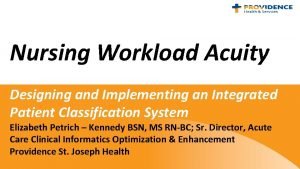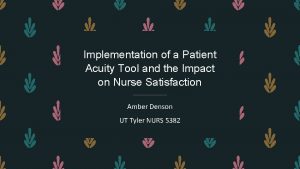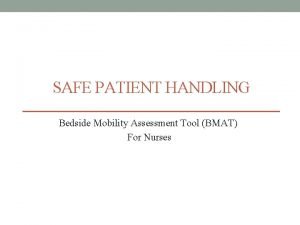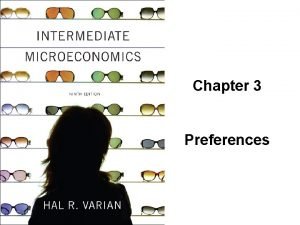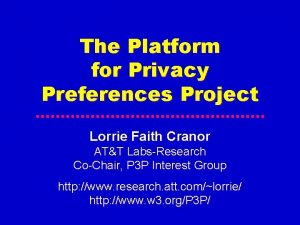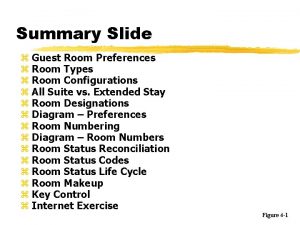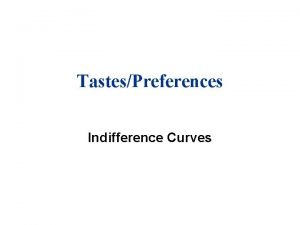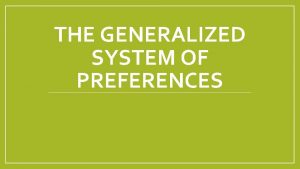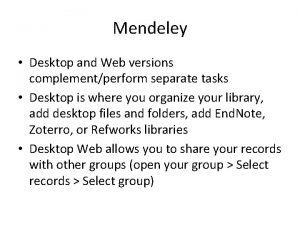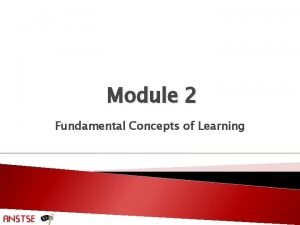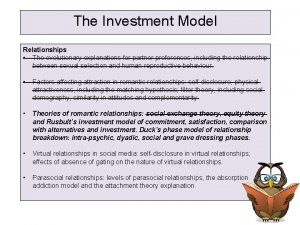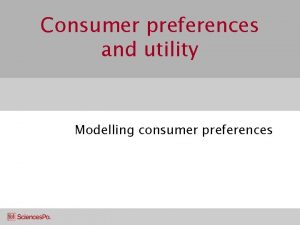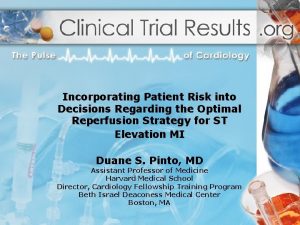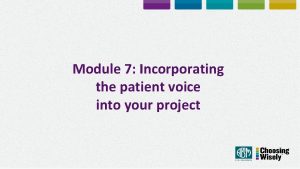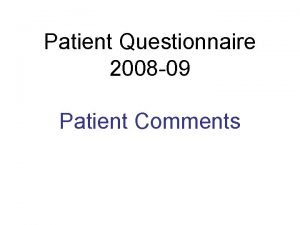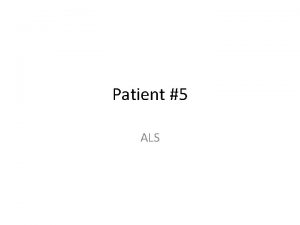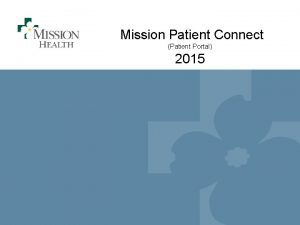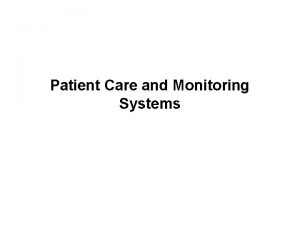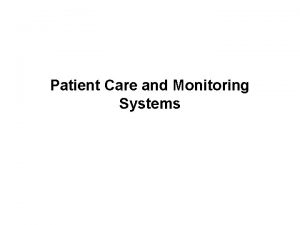ePreference A Tool for Incorporating Patient Preferences into




















































- Slides: 52

e-Preference: A Tool for Incorporating Patient Preferences into Health Decision Aids Amar K. Das, MD, Ph. D Assistant Professor Departments of Medicine (Medical Informatics) and Psychiatry and Behavioral Sciences Stanford University

Outline § § Health decision aids Clinical example e-Preference approach Prototype system and evaluation

Health Decisions in Aging § Older individuals often face complex health decisions involving significant risk of morbidity and/or mortality § Patient participation is desirable in such decisions § Clinicians’ ability to facilitate shared decision making varies

Health Decision Aids § Focus typically on Improvements in patient knowledge Explanation of treatment alternatives Communication of risk

HDA Presentation § Non-interactive formats Brochure (paper booklet or Web based) Audiotape Video § Interactive formats Decision board Computer Multimedia

Outline § § Health decision aids Clinical example e-Preference approach Prototype system and evaluation

Atrial Fibrillation § Atrial fibrillation leads to a significant risk of stroke, ranging from 1% to 15% per year, based on patient factors § Anticoagulation therapy (warfarin) can reduce the risk of stroke by approximately two thirds, but incurs a risk of major bleeding complications of 1% to 3% per year

Measuring Preferences § Eight studies that modeled treatment preferences of patients with atrial fibrillation § Studies used three methods Probability tradeoff technique Decision aid Decision analysis (Man-Son-Hing et al. , 2005)

Audiobooklet (Man-Son-Hing et al. , 2000)

Audiobooklet (Man-Son-Hing et al. , 2000)

Audiobooklet (Man-Son-Hing et al. , 2000)

Decision Analysis (Protheroe et al. , 2000)

Decision Analysis (Protheroe et al. , 2000) Decision Analysis Guideline Treat Do not treat Total Treat 48 22 70 Do not treat 11 16 27 59 38 97 28 on treatment 17 on treatment

Decision-Support Tool (Thomson et al. , 2002)

Decision-Support Tool (Thomson et al. , 2002)

HDA Limitations § Typically designed for one type of health decision § May not provide patient-specific information on alternatives and risks § May be only accessible in particular settings § Does not have readily modifiable design

Design Desiderata for HDAs § We need a design that can Be tailored to specific health problems Incorporate patient-specific data Be accessible via the Internet Be easily modified

Outline § § Health decision aids Clinical example e-Preference approach Prototype system and evaluation

Motivation for e-Preference § Create an environment for clinical experts and software developers to design and implement HDAs § Based on our research group’s long standing interest in developing customizable and reusable software architectures for decision support

EON Architecture End-User Application Protégé Problem-Solving Method Query Engine Protocol KB Patient Database

Design of e-Preference § A set of software methods for Knowledge representation Decision-analytic computation Data access from existing database Web-based multimedia presentation

e-Preference Architecture HDA FLAIR Protégé Netica Query Engine KBDM Patient Database

Knowledge-Based Decision Model § Encode concepts related to Influence diagrams Health decisions and outcomes Risk factors Patient preferences Relationships between these factors

Netica

FLAIR

Aristotle’s Categories Supreme genus: Differentiae: SUBSTANCE material Subordinate genera: Differentiae: BODY animate Subordinate genera: Differentiae: inanimate sensitive MINERAL insensitive ANIMAL rational Species: Individuals: SPIRIT LIVING Proximate genera: Differentiae: immaterial PLANT irrational HUMAN Socrates Plato BEAST Aristotle …


The NCI Thesaurus

Structuring Knowledge

Web Ontology Language § A Semantic Web standard to use ontologies to represent knowledge on the Internet § OWL can be used to build ontologies of highlevel descriptions, based on three concepts: Classes (e. g. , Influence Diagram, Nodes, Patient) Properties (e. g. , has_node, has_disease) Individuals (e. g. , “atrial fibrilaton”)

OWL Example Patient Influence Diagrams has_chance_node AF E. My. Chart has_model has_diagnosis Diagnoses AF DM Nodes Decision Chance Outcome

Semantic Web Rule Language § A language for expressing logical rules in terms of OWL concepts § Rules in SWRL can be used to deduce new knowledge about an existing OWL ontology Patient(? pt) ^ has_dx(? pt, ? dx) ^ has_model(dx, ? hda) activate_HDA(? pt, ? hda)


Making Restrictions



Generating a Decision Model

Remaining Challenges § Modeling and editing probabilities in Protégé OWL § Generating interface based on modified influence diagram

KBDM Approach § Advantages Ability to modify knowledgebase and create tailored decision model for HDA § Disadvantages Efforts needed for acquiring and maintaining knowledge

Outline § § Health decision aids Clinical example e-Preference approach Prototype system and evaluation











Conclusions § HDAs can help to incorporate patient preferences into shared decision making § The knowledge used in developing HDAs using decision analyses can be encoded § Such knowledge can be used to generate and tailor HDAs

Acknowledgments Stanford Medical Informatics Bilal Ahmed Yael Garten Jeremy Robin Daniel Rubin Ravi Shankar Samson Tu Center for Primary Care and Outcomes Research Mary Goldstein Doug Owens Tamara Sims NIA and CADMA for funding support
 Nested quotation example
Nested quotation example Incorporating pronunciation
Incorporating pronunciation Incorporating the change
Incorporating the change Incorporating in ohio
Incorporating in ohio Nn
Nn Methods of incorporating risk in capital budgeting
Methods of incorporating risk in capital budgeting Patient 2 patient
Patient 2 patient Epic acuity tool
Epic acuity tool Icu acuity tool
Icu acuity tool Banner mobility assessment tool
Banner mobility assessment tool Well-behaved preferences are
Well-behaved preferences are Platform for privacy preferences project
Platform for privacy preferences project Room status
Room status Weakly preferred vs strictly preferred
Weakly preferred vs strictly preferred Regrets and wishes
Regrets and wishes Vcaa course search
Vcaa course search Career choices and preferences in hrm
Career choices and preferences in hrm Generalised system of preferences wto
Generalised system of preferences wto Router preferences
Router preferences Mendeley desktop preferences
Mendeley desktop preferences Example of claim of fact
Example of claim of fact How do you save panel locations and visibility preferences?
How do you save panel locations and visibility preferences? Vtac aggregate to atar table 2020
Vtac aggregate to atar table 2020 Types of learning
Types of learning Icwa placement preferences
Icwa placement preferences Elders housing preferences reflect a strong desire for
Elders housing preferences reflect a strong desire for Flight preferences
Flight preferences Evolutionary explanations for partner preferences
Evolutionary explanations for partner preferences Potter's tool is data cleaning tool
Potter's tool is data cleaning tool Smärtskolan kunskap för livet
Smärtskolan kunskap för livet Vad är referatmarkeringar
Vad är referatmarkeringar Karttecken kraftledning
Karttecken kraftledning Mjälthilus
Mjälthilus Autokratiskt ledarskap
Autokratiskt ledarskap Arkimedes princip formel
Arkimedes princip formel Enheter för massa
Enheter för massa Adressändring ideell förening
Adressändring ideell förening Blomman för dagen drog
Blomman för dagen drog Elektronik för barn
Elektronik för barn Borra hål för knoppar
Borra hål för knoppar Mat för idrottare
Mat för idrottare Bris för vuxna
Bris för vuxna Jiddisch
Jiddisch Etik och ledarskap etisk kod för chefer
Etik och ledarskap etisk kod för chefer Trög för kemist
Trög för kemist Humanitr
Humanitr Datorkunskap för nybörjare
Datorkunskap för nybörjare Steg för steg rita
Steg för steg rita Kontinuitetshantering
Kontinuitetshantering Returpilarna
Returpilarna Redogör för vad psykologi är
Redogör för vad psykologi är Lek med geometriska former
Lek med geometriska former Bästa kameran för astrofoto
Bästa kameran för astrofoto







